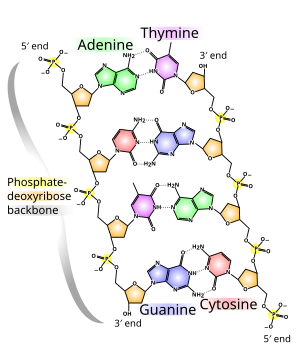Physical definitions
The vast majority of living organisms encode their genes in long strands of DNA. DNA consists of a chain made from four types of nucleotide subunits: adenine, cytosine,guanine, and thymine. Each nucleotide subunit consists of three components: aphosphate group, a deoxyribose sugar ring, and a nucleobase. Thus, nucleotides in DNA or RNA are typically called 'bases'; consequently they are commonly referred to simply by their purine or pyrimidine original base components adenine, cytosine, guanine, thymine. Adenine and guanine are purines and cytosine and thymine are pyrimidines. The most common form of DNA in a cell is in a double helix structure, in which two individual DNA strands twist around each other in a right-handed spiral. In this structure, the base pairing rules specify that guanine pairs with cytosine andadenine pairs with thymine (each pair contains one purine and one pyrimidine). The base pairing between guanine and cytosine forms three hydrogen bonds, while the base pairing between adenine and thymine forms two hydrogen bonds. The two strands in a double helix must therefore be complementary, that is, their bases must align such that the adenines of one strand are paired with the thymines of the other strand, and so on.
Due to the chemical composition of the pentose residues of the bases, DNA strands have directionality. One end of a DNA polymer contains an exposed hydroxyl group on the deoxyribose, this is known as the 3' end of the molecule. The other end contains an exposed phosphate group, this is the 5' end. The directionality of DNA is vitally important to many cellular processes, since double helices are necessarily directional (a strand running 5'-3' pairs with a complementary strand running 3'-5') and processes such as DNA replication occur in only one direction. All nucleic acid synthesis in a cell occurs in the 5'-3' direction, because new monomers are added via a dehydration reaction that uses the exposed 3' hydroxyl as a nucleophile.
The expression of genes encoded in DNA begins by transcribing the gene into RNA, a second type of nucleic acid that is very similar to DNA, but whose monomers contain the sugar ribose rather than deoxyribose. RNA also contains the base uracil in place of thymine. RNA molecules are less stable than DNA and are typically single-stranded. Genes that encode proteins are composed of a series of three-nucleotidesequences called codons, which serve as the "words" in the genetic "language". The genetic code specifies the correspondence during protein translation between codons and amino acids. The genetic code is nearly the same for all known organisms.

No comments:
Post a Comment